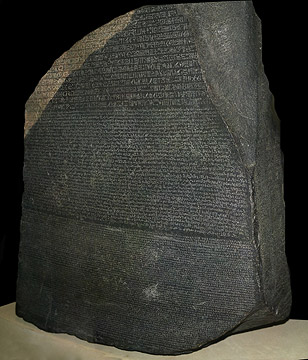Image Resource Bank
Image Gallery |  8 of 15
8 of 15 
Rosetta Stone
The campaign against Egypt and Syria launched by the French general Napoleon Bonaparte in 1798 CE had strategic and geopolitical motives: to tie North Africa and the Levant more closely to the economies of continental Europe, and to hinder the development of British colonial power beyond the Mediterranean, especially in India. The campaign failed disastrously to accomplish these aims. But Napoleon’s invading force was accompanied by a corps of 160 “savants,” imitating the scholars who accompanied Alexander the Great. Decades after the military catastrophe that cost so many lives, these scholars produced a detailed thirty-seven-volume account of Egyptian geography, topography, languages, society, and monuments that surpassed every earlier account of exploration and research in the East.
One of the items that these French savants found was the Rosetta Stone, a stele with a royal decree recorded in two Egyptian scripts and in Greek. The Egyptian scripts were not yet deciphered, but the Greek could be read. This was the key to the decipherment of ancient Egyptian scripts, accomplished by Jean-François Champollion (1790-1832 CE) and others. This decipherment opened the records of Egyptian history stretching back for almost four thousand years.
After the British helped drive the French armies out of Egypt, the Rosetta Stone was among the trophies of victory. It is now displayed in the British Museum, where visitors are provoked to ask who, if anybody, owns this key to the heritage of ancient Egypt.
Name: Rosetta Stone
Material: Granodiorite
Size:
Height: 1.144 m (3.75 ft)
Width: 72.3 cm (28.46 in)
Depth: 27.9 cm (10.98 in)
Date: 196 BCE
Place of Origin: Egypt
Location: The British Museum, London, United Kingdom
Source and Registration#: Wikimedia Commons. Link to resource![]() (accessed August 17, 2009).
(accessed August 17, 2009).

 Matthew W. Stolper
Matthew W. Stolper
Professor of Assyriology and the John A. Wilson Professor of Oriental Studies




